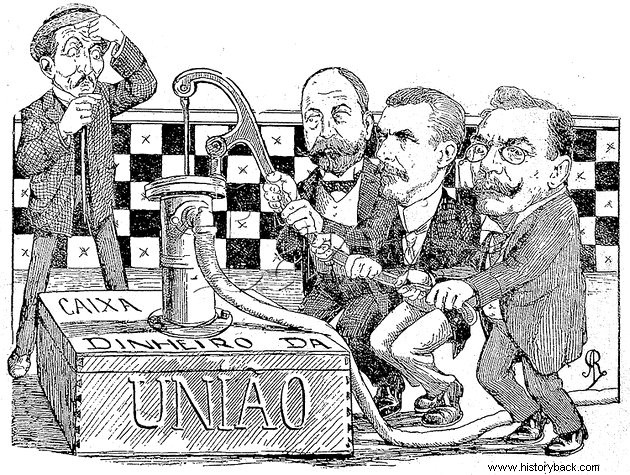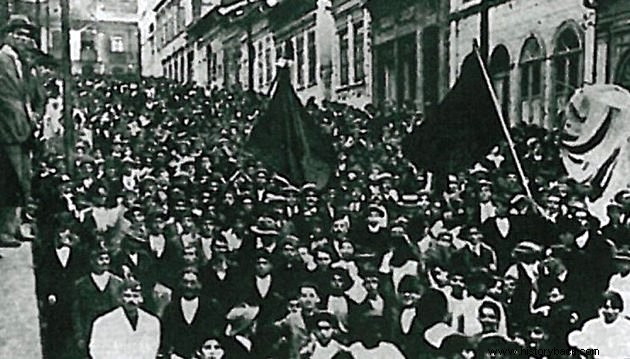First Republic is the period of history in Brazil from the end of the monarchy on November 15, 1889 to the Revolution of 1930.
It has also been called by historians the Oligarchic Republic, Republic of Colonels and Republic of Café com Leite.
With the victory of the Revolution of 30 and in order to reinforce the idea that a new era had begun, it became pejoratively called the Old Republic .
First Republic:summary
The first president of the so-called First Republic was Marechal Deodoro da Fonseca and the last, Washington Luís.
In 1891, Deodoro da Fonseca resigns and, in his place, his vice-president, Floriano Peixoto, takes over. For his part, the first civilian president was Prudente de Moraes, elected in 1894.
For study purposes, the First Republic is divided into two periods:
- República da Espada (1889-1894):military governments of Deodoro da Fonseca and Floriano Peixoto
- Oligarchic Republic (1895-1930):governments of rural oligarchies in São Paulo and Minas Gerais. It's called coronelismo, practiced mainly by coffee growers, allied with rural producers from other states.
During this period, the country was governed by the Constitution promulgated in 1891. The Magna Carta established the presidential regime, the vote for those over 21 years of age, freedom of worship, mandatory civil marriage, among other measures. This was Brazil's second constitution, the first after the Proclamation of the Republic.
Read more:
See also:Constitution of 1891Characteristics of the First Republic
The First Republic is characterized by a troubled period in the history of Brazil.
The new regime cannot satisfy the dreams of the humblest and wars such as the Canudos War (1893-1897) and Contestado (1912-1916) are fought leaving thousands dead.
Conflicts were also recorded in large cities such as the Vaccine Revolt (1904) or the Lash Revolt (1910).
The political and economic elite guaranteed its permanence in power through fraudulent elections and exchange of favors. The economy, dependent on coffee, was trying to diversify with an incipient industrialization.
Read more about:
- War of the Contested
- Revolt of the Whip
Governors Policy

The governors' policy was the system of alliances based on the exchange of political favors.
In this way, the governors supported the election of a National Congress favorable to the president. In exchange, they received more resources and guaranteed appointments to political positions for the allies.
See also:Governors PolicyAnother name given to this political system was "coffee with milk policy". This name referred to the alternation of power of presidents from Minas Gerais and São Paulo or who were supported by these states.
Both states were dominated by the PRM (Partido Republicano Mineiro) and PRP (Partido Republicano Paulista).
Despite being a widespread myth, the greatest wealth of Minas Gerais was coffee and not milk. The leading coffee state was São Paulo.
See also:Coffee with Milk PolicyElectoral System in the First Republic
At the beginning of the first republic, open voting was instituted for people over 21 years old to citizens who could read and write. However, soldiers and religious were excluded from the electoral process.
Women, on the other hand, lived in an ambiguous situation, as the Brazilian Constitution specified that only men could vote, but did not explicitly prohibit the female vote. This loophole was taken advantage of so that some women requested their right to vote.
However, the majority of the population was illiterate and of the 12 million inhabitants, only 10% managed to participate in the electoral process.
The elections were marked by fraud and the colonels indicated who the poor voter should vote for, the so-called halter vote.
The outcome of the elections was in charge of the Verification Commission. This commission was favorable to the president and, not infrequently, distorted results by approving names of allied deputies and senators.
Economy in the First Republic
The economy of this period was predominantly rural, with an emphasis on coffee production, which accounted for more than 50% of Brazilian exports throughout the First Republic.
The production of sugar, cotton, rubber and cocoa also took part.
The state that concentrated the largest coffee production at this time was São Paulo. The region has become a center of attraction for both Brazilians and immigrants.
Industrialization
At this time, we see the growth of the industry, with emphasis on the city of São Paulo, which concentrated 31% of the factories in Brazil.
Parallel to the growth of the working class. there is the beginning of workers' movements demanding better working conditions and guarantee of labor rights.
Many of these organizations were led by immigrants who brought new ideas that were in vogue in Europe such as anarchism.
With the outbreak of the First World War (1914-1918) and the difficulty of importing industrialized products, the industry in Brazil will gain more relevance.
See also:Industrialization in BrazilTaubaté Agreement

As we have seen, the Brazilian political situation was guided by the coffee economy and the arrangements that governors could obtain to obtain favors from the federal government.
Brazilian production corresponded to two thirds of the international market. Once cared for by enslaved blacks, the coffee plantations now had foreign salaried labor.
To make more profit, farmers increased production and this led to excess coffee, and the price dropped sharply, diminishing earnings.
Thus, coffee producers gathered in the city of Taubaté, in São Paulo, in 1906, in order to solve the crisis. This meeting went down in history as the Taubaté Convention.
At this meeting it was decided that the government would be responsible for storing the surplus to sell when coffee prices improve.
That way, the farmers wouldn't have any losses and wouldn't go bankrupt. To buy excess coffee, the government borrowed abroad.
Overproduction continued and the government stockpiled coffee without being able to find an opportunity to sell it. The situation worsened when the Crisis of 1929 began and the volume of trade worldwide decreased.
Social Movements in the First Republic

The period of the First Republic is marked by the continuity of industrialization in Brazil. The first textile or building materials factories were installed, especially in São Paulo and Rio de Janeiro.
Brazil had 600 factories and employed 54,000 workers in 1889. In 1922, there were 13,000 factories where 275,000 people worked.
Industrial expansion resulted in the formation of the working class, but there was no guarantee of labor rights. Therefore, factory owners imposed heavy workloads, with up to 15 hours of daily production.
There was no right to vacation, wages were very low and the facilities were unhealthy. Physical violence, especially against children, was not uncommon either.
Then, workers' mobilization began with the creation of Mutual Relief Funds and also of workers' committees. These aimed at improving working conditions, avoiding the exploitation of underage workers and fighting the high cost of living.
This movement is the precursor of Brazilian trade union activity. Still in 1917, the first strike began in São Paulo, which had repercussions throughout Brazil and gave rise to the first labor laws.
End of the First Republic:the Coup of 1930
The cycle of the First Republic comes to an end with the coup of 1930, against President Washington Luís.
The economic crisis caused by the drop in coffee prices and the dissatisfaction of governors who were outside oligarchic politics ended up causing a rupture in this system.
The governors of Rio Grande do Sul and Paraíba, supported by states that did not benefit from the café au lait policy, joined forces to present the candidacy of Getúlio Vargas from Rio Grande do Sul.
In this way, when the São Paulo candidate Júlio Prestes is the winner of the 1930 elections, Vargas prevents his inauguration, supported by the Army.
As there was no reaction to defend the government, Vargas assumed the presidency of the Republic and would remain there until 1945.
Complement your research by reading:
- Brazil Republic
